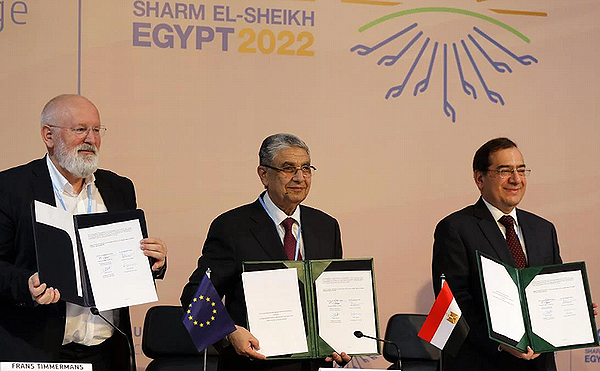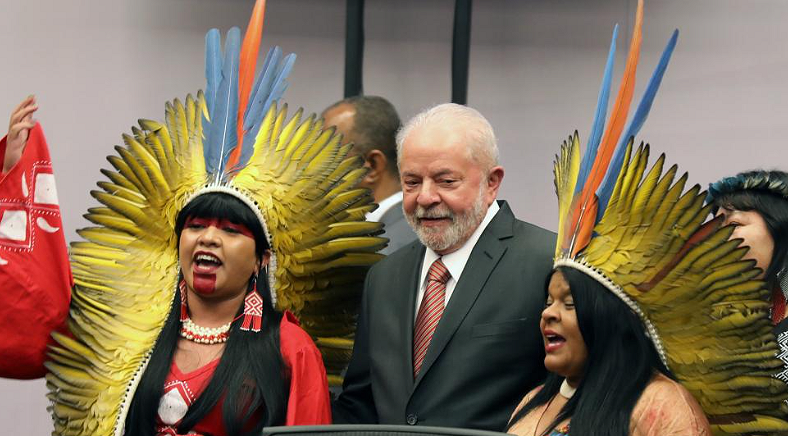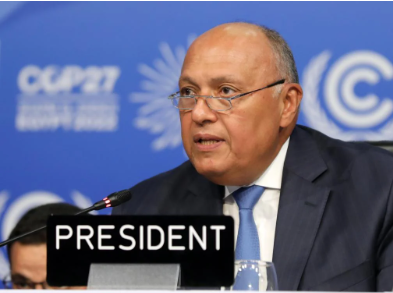
SHARM el-SHEIKH, Egypt, November 20, 2022 (ENS) – The UN Climate Change Conference COP27 closed today in Egypt with a breakthrough agreement to provide “loss and damage” funding for vulnerable countries hit hard by climate disasters. Creating a specific fund for loss and damage marked an important point of progress, with the issue added to the official agenda and adopted for the first time at COP27.
“This outcome moves us forward,” said Simon Stiell, the new UN Climate Change executive secretary, as his first COP concluded. “We have determined a way forward on a decades-long conversation on funding for loss and damage – deliberating over how we address the impacts on communities whose lives and livelihoods have been ruined by the very worst impacts of climate change.”
Yeb Saño of the Philippines, executive director Greenpeace Southeast Asia, who heads the Greenpeace delegation at the COP, was encouraged by the new funding. “The agreement for a Loss and Damage Finance Fund marks a new dawn for climate justice. Governments have laid the cornerstone of a long overdue new fund to deliver vital support to vulnerable countries and communities who are already being devastated by the accelerating climate crisis,” he said.
“Well into overtime, these negotiations have been marred by attempts to trade adaptation and mitigation against loss and damage,” Saño said. “In the end they were pulled back from the precipice by the concerted effort of developing countries standing firm and by climate activists’ demands for the blockers to step up.”
COP27 brought more than 45,000 participants together at this resort town at the tip of the Sinai Peninsula to share ideas, solutions, build partnerships and coalitions. Indigenous peoples, local communities, cities and civil society, including youth and children, showcased how they are addressing climate change and shared how planetary warming impacts their lives.
Set against a difficult geopolitical backdrop, COP27 resulted in countries delivering a package of decisions that reaffirmed their commitment to limit global temperature rise to 1.5 degrees Celsius above pre-industrial levels, one of the goals of the 2015 Paris Agreement on climate.

The decisions strengthened action by countries to cut greenhouse gas emissions and adapt to those impacts of climate change that are already inevitable, as well as boosting the support of finance, technology and capacity-building that developing countries need.
Governments took the ground-breaking decision to establish new funding arrangements, and they decided to set up a dedicated fund to assist developing countries in responding to loss and damage.
Governments also agreed to establish a “transitional committee” to make recommendations on how to operationalize both the new funding arrangements and the fund itself at COP28 next year. The first meeting of the transitional committee is expected to take place by the end of March 2023.
Parties agreed on the institutional arrangements to operationalize the Santiago Network for Loss and Damage, to catalyze technical assistance to developing countries that are particularly vulnerable to the adverse effects of climate change.
COP27 also made progress on adaptation, with governments agreeing on the way to move forward on the Global Goal on Adaptation, which will conclude at COP28 and inform the first Global Stocktake, improving resilience amongst the most vulnerable.
New pledges, totaling more than US$230 million, were made to the Adaptation Fund at COP27 to help more vulnerable communities adapt to climate change through concrete adaptation solutions.
COP27 President and Egypt’s Foreign Minister Sameh Shoukry announced the Sharm el-Sheikh Adaptation Agenda, aimed at enhancing resilience for people living in the most climate-vulnerable communities by 2030.
UN Climate Change’s Standing Committee on Finance was requested to prepare a report for consideration at COP28 next year on doubling adaptation finance.
A global transformation to a low-carbon economy is expected to require investments of at least US$4 to $6 trillion a year, according to a decision known as the Sharm el-Sheikh Implementation Plan.
Delivering such funding will require a swift and comprehensive transformation of the financial system and its structures and processes, engaging governments, central banks, commercial banks, institutional investors and other financial actors.
Serious concern was expressed that the goal of developed country Parties to the Paris Agreement on climate to mobilize jointly US$100 billion per year by 2020 has not yet been met, with developed countries urged to meet the goal, and multilateral development banks and international financial institutions called on to mobilize climate finance.
At COP27, deliberations continued on setting a “new collective quantified goal on climate finance” in 2024, taking into account the needs and priorities of developing countries.
“In this text we have been given reassurances that there is no room for backsliding,” said Stiell. “It gives the key political signals that indicate the phasedown of all fossil fuels is happening.”
World Leaders Kicked COP27 Into Action
The World Leaders Summit, held over two days during the first week of the conference, convened six high-level roundtable discussions highlighting solutions on themes such as food security, vulnerable communities and a just transition. They considered how to chart a path to overcome climate challenges and how to provide the finance, resources and tools to deliver climate action at a scale that will be effective.
The decisions taken here today re-emphasize the critical importance of empowering all stakeholders to engage in climate action; in particular through the five-year action plan on Action for Climate Empowerment and the intermediate review of the Gender Action Plan.

Young people in particular were given greater prominence at COP27, with the first pavilion for children and youth, as well as the first-ever youth-led Climate Forum. Executive Secretary Stiell promised to urge governments to not just listen to the solutions put forward by young people, but to incorporate those solutions in decisions and policy making.
In parallel with the formal negotiations, the Global Climate Action space at COP27 provided a platform for governments, businesses and civil society to collaborate and showcase their climate solutions.
The UN Climate Change High-Level Champions held a two-week program of more than 50 events, including major African-led initiatives to cut emissions and build climate resilience, and work on the mobilization of finance.
“We have a series of milestones ahead. We must pull together, with resolve, through all processes, may they be national, regional, or others such as the G20. Every single milestone matters and builds momentum,” said Stiell. “The next step for change is just around the corner, with the United Arab Emirates’ stewardship of the First Global Stocktake.”
“For the very first time we will take stock of the implementation of the Paris Agreement. It will independently evaluate the progress we have made and if our goals are adequate. It will inform what everybody, every single day, everywhere in the world, needs to do, to avert the climate crisis,” Stiell said.
Stiell reminded delegates in the closing plenary session that the world is in a critical decade for climate action. A stark report from UN Climate Change, UNFCCC, underpinned his remarks, as well as discussions throughout the two-week conference.
According to the UNFCCC report, implementation of current pledges by national governments put the world on track for a 2.5°C warmer world by the end of the century.

The UN’s Intergovernmental Panel on Climate Change indicates that greenhouse gas emissions must decline 45 percent by 2030 to limit global warming to 1.5°C.
COP27 President Sameh Shoukry said, “The work that we’ve managed to do here in the past two weeks, and the results we have together achieved, are a testament to our collective will, as a community of nations, to voice a clear message that rings loudly today, here in this room and around the world: that multilateral diplomacy still work.”
“Despite the difficulties and challenges of our times, the divergence of views, level of ambition or apprehension, we remain committed to the fight against climate change,” Shoukry said. “We rose to the occasion, upheld our responsibilities and undertook the important decisive political decisions that millions around the world expect from us.”
Before COP28 – The Year Ahead
Speaking about 2023, Stiell said UN Climate Change will help Parties and future COP Presidencies to navigate the path to the new phase of implementation.
There were other key outcomes of COP27, including:
Technology
COP27 saw the launch of a new five-year work program to promote climate technology solutions in developing countries.
Mitigation
A mitigation work program was launched at COP27, aimed at urgently scaling up mitigation ambition and implementation. The work program will start immediately following COP27 and continue until 2030, with at least two global dialogues held each year. Governments were asked to revisit and strengthen the 2030 targets in their national climate plans by the end of next year, as well as accelerate efforts to phase down unabated coal power and phase out inefficient fossil fuel subsidies.
The decision text recognizes that the unprecedented global energy crisis underlines the urgency to rapidly transform energy systems to be more secure, reliable, and resilient, by accelerating clean and just transitions to renewable energy during this critical decade of action.
Global Stocktake: a mechanism to raise ambition under the Paris Agreement
Delegates at COP27 wrapped up the second technical dialogue of the first global stocktake. The UN Secretary-General will convene a “climate ambition summit” in 2023, ahead of the conclusion of the stocktake at COP28 next year.
“The global stocktake is an ambition exercise. It’s an accountability exercise. It’s an acceleration exercise,” said Stiell. “It’s an exercise that is intended to make sure every Party is holding up their end of the bargain, knows where they need to go next and how rapidly they need to move to fulfill the goals of the Paris Agreement.”
“We were pleased by the meaningful discussions and engagement by all participants,” said Farhan Akhtar, co-facilitator of the technical dialogue. “While, understandably, perspectives differed across the room, we hope that … we are building understanding of our challenges and where there are opportunities to address them.”
Although the dialogue centers on taking stock of past actions, it is also about forward momentum to unlock more ambitious climate action and support.
“A significant part of this exercise is about identifying opportunities for action: on mitigation, on adaptation, on finance, on transparency and incorporating what those outside the process are doing as well,” said Stiell. “It’s about where do we stand in order to inform here’s where we should go next.”
Countries Collaborate
- – Countries launched a package of 25 new collaborative actions in five key areas: power, road transport, steel, hydrogen and agriculture.
- – Progress was made on forest protection with the launch of the Forest and Climate Leaders’ Partnership, which aims to unite action by governments, businesses and community leaders to halt forest loss and land degradation by 2030.
- – UN Secretary-General António Guterres announced a US$3.1 billion plan to ensure everyone on the planet is protected by early warning systems within the next five years.
- – The UN Secretary-General’s High-Level Expert Group on Net-Zero Commitments published a report at COP27. It serves as a guide to ensure credible, accountable net-zero pledges by industry, financial institutions, cities and regions.
- – A G7-led plan called the Global Shield Financing Facility was launched at COP27 to provide funding to countries suffering climate disasters.
- – Announcing a total of US$105.6 million in new funding, Denmark, Finland, Germany, Ireland, Slovenia, Sweden, Switzerland, and the Walloon Region of Belgium, stressed the need for even more support for the Global Environment Facility funds targeting the immediate climate adaptation needs of low-lying and low-income states.
- – The new Indonesia Just Energy Transition Partnership, announced at the G20 Summit held in parallel with COP27, will mobilize US$20 billion over the next three to five years to accelerate a just energy transition.
- – A network of green shipping corridors will encircle the globe as the shipping industry transitions off fossil fuels and begins to move toward net-zero emissions.
- – With the launch during COP 27 of the Mangrove Breakthrough initiative by the Global Mangrove Alliance and the UN Climate Change High-level Champions, the potential and challenges of harnessing the natural power of “blue carbon” ecosystems has received increased recognition and momentum. Co-led by IUCN in collaboration with the UN High Level Climate Champions, it aims to secure 15 million hectares of mangroves globally by 2030.
- – IUCN and the International Federation of Red Cross and Red Crescent Societies began a new area of work to deploy nature-based solutions to address humanitarian challenges.
Featured image: Young people stage a demonstration in support of loss and damage reparations by rich countries that are major emitters of greenhouse gases to poorer countries that emit little climate pollution but suffer rising sea levels, fierce hurricanes and other serious climate damages. (Photo by IISD/ENB | Mike Muzurakis)
© 2022, Environment News Service. All rights reserved. Content may be quoted only with proper attribution and a direct link to the original article. Full reproduction is prohibited.



